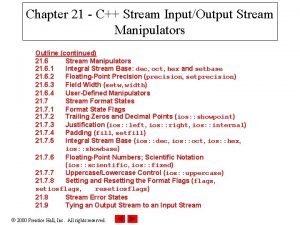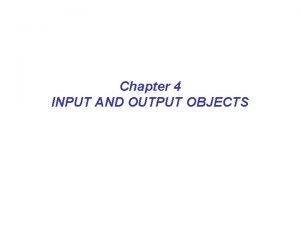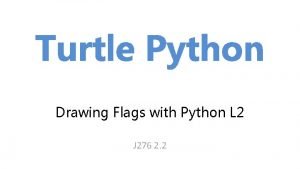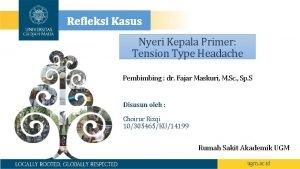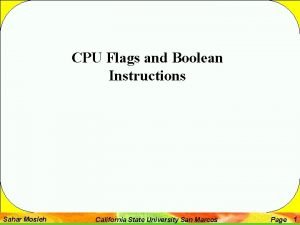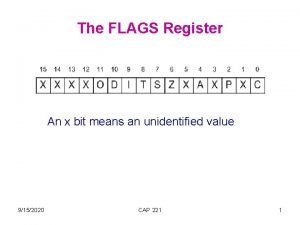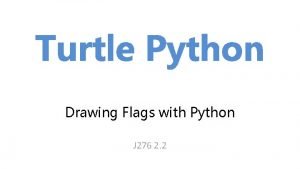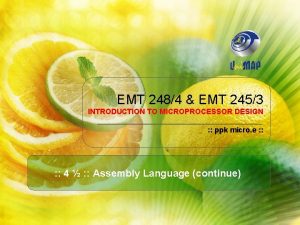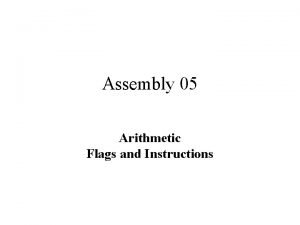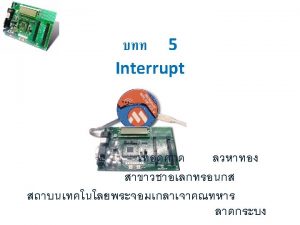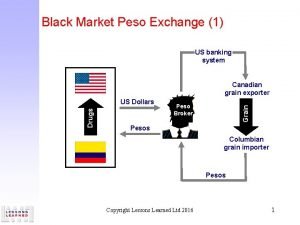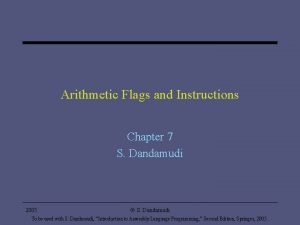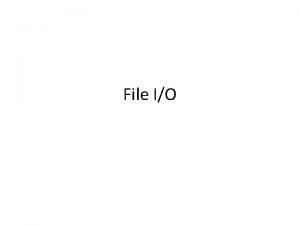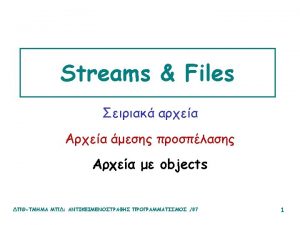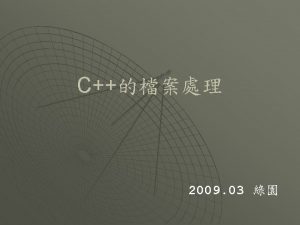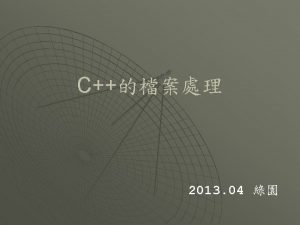flags fixed setiosflags ios fixed ios fixedflags the






































![39 const int N = 5; double M 2 D[M][N]; double Pick. V [N]; 39 const int N = 5; double M 2 D[M][N]; double Pick. V [N];](https://slidetodoc.com/presentation_image_h2/9249db3cf8fd653a999ad6bb442652d6/image-39.jpg)

![41 // --- 函數 Show. Matrix() 的定義 -----------void Show. Matrix (double A[][N]) { cout 41 // --- 函數 Show. Matrix() 的定義 -----------void Show. Matrix (double A[][N]) { cout](https://slidetodoc.com/presentation_image_h2/9249db3cf8fd653a999ad6bb442652d6/image-41.jpg)
![// --- 函數 Show. Vector () 的定義 ----------void Show. Vector (double A[]) { cout // --- 函數 Show. Vector () 的定義 ----------void Show. Vector (double A[]) { cout](https://slidetodoc.com/presentation_image_h2/9249db3cf8fd653a999ad6bb442652d6/image-42.jpg)
![// --- 函數 Pick. Row() 的定義 ------------void Pick. Row(double A[][N], double B[], int S) // --- 函數 Pick. Row() 的定義 ------------void Pick. Row(double A[][N], double B[], int S)](https://slidetodoc.com/presentation_image_h2/9249db3cf8fd653a999ad6bb442652d6/image-43.jpg)

- Slides: 44








旗標 (flags) 格式操縱子 fixed 也可以寫成 setiosflags (ios: : fixed) 這裹ios: : fixed這類表示式稱為旗標(flags) 。 運算子「: : 」稱為範圍運算子 (the scope operator), 或範圍確認運算子 (the scope resolution operator)。 使用這個語法時,using宣告必需寫成 using std: : setiosflags; using std: : ios; 而不是 using std: : fixed; 8

格式操縱子的實例 表 13. 1. 2 Manipulator 9 輸 cout << setw(2) << 3 ; << endl cout << setw(5) << 158 ; << endl cout << setw(5) << 69. 72 ; << endl cout << setw(5) << left << endl ; << 876 出 | 3| | 158| |69. 72| cout << setw(6) << fixed << setprecision(2) << 133. 456 << endl ; |876 | |133. 46|



範例程式 檔案 Format_1. cpp 12 // Format_1. cpp #include <iostream> #include <iomanip> using namespace std; int main() { cout << '|' << setw(2) << 3 cout << '|' << setw(5) << 158 cout << '|' << setw(5) << 69. 72 cout << setiosflags(ios: : left) << '|' << setw(5) << 876 cout << setiosflags(ios: : fixed) << setprecision(2) << '|' << setw(6) << 133. 456 return 0; } << '|' << endl ; << '|‘ << endl ; << '|' << endl ;

操作結果 | 3| | 158| |69. 72| |876 | |133. 46| 13



範例程式 檔案 Format_2. cpp 16 // Format_2. cpp #include <iostream> #include <iomanip> using namespace std; // --- 主程式 ---------------int main() { cout << hex << '|' << 14 << '|' << endl; cout << scientific << setprecision(2) << '|' << setw(5) << 46218. 542 << '|' << endl; cout << setprecision (4) << fixed << showpoint << '|' << setw(13) << 64. 7766 << '|' << endl ; }

操作結果 |e| |4. 62 e+04| | 64. 7766| 17

13. 2 輸出格式設定間的交互作用 表 13. 2 旗標 (不指定) t 1 t 2 setprecision(5) t 1 t 2 253 1. 23457 e-01 2. 5 e+02 1. 25 e-0 2. 5 e+02 1. 23 e-01 253. 00 1. 23457 e-01 showpoint fixed 253. 00 0. 13346 showpoint scientific 2. 53 e+02 1. 23 e-01 2. 53000 e+02 showopint 18 setprecision(2) 253. 00000 1. 23457 e-01


範例程式 檔案 Format_3_Short. cpp (獲 得表 13. 2) // Format_3_Short. cpp #include <iostream> #include <iomanip> using namespace std; // --- 主程式 ----------------int main() { double t 1=253. 0; double t 2=0. 123456789; cout 20 << " (1)The value of t 1 is : " << std: : setprecision(2) << t 1 << endl; << " (2)The value of t 1 is : "

<< std: : setprecision(3) << std: : showpoint << t 1 << endl; cout << " (3)The value of t 1 is : " << std: : setprecision(5) << std: : showpoint << std: : fixed << t 1 << endl; cout << " (4)The value of t 1 is : " << std: : setprecision(5) << std: : showpoint << std: : scientific << t 1 << endl; return 0; } 21

操作結果 (1) The value of t 1 is : (2) The value of t 1 is : (3) The value of t 1 is : (4) The value of t 1 is : 22 2. 5 e+02 253. 00000 2. 53000 e+02

三種格式設定語法之比較 (以下三組敘述 的效果完全相同) (3 -1) (1) 在Format_1. cpp中的語法 cout << setiosflags (ios: : fixed||ios: : showpoint) << setprecision (2) << t 1 << endl; cout << setiosflags (ios: : hex) << 26; 23

前置處理指令之後的 using指令 (1) 要配合: #include <iomanip> using std: : cout; using std: : endl; using std: : setiosflags; using std: : ios; using std: : setprecision; 24

三種格式設定語法之比較 (3 -2) (2) 在Format_2. cpp中的語法 cout << fixed << showpoint << setprecision (2) << t 1 <<endl; cout << hex << 26; 25

前置處理指令之後的 using指令 (2) 要配合: #include <iomanip> using std: : cout; using std: : endl; using std: : fixed; using std: : showpoint; using std: : setprecision; using std: : hex; 26

三種格式設定語法之比較 (3 -3) (2) 在Format_3. cpp中的語法 cout << std: : fixed << std: : showpoint << std: : setprecision (2) << t 1 << endl; cout << std: : hex << 26; 27

前置處理指令之後的 using指令 (3) 要配合 (最簡短): #include <iomanip> using std: : cout; using std: : endl; 28



範例程式 檔案 Save. Matrix. cpp // Save. Matrix. cpp #include <iostream> #include <iomanip> #include <fstream> using namespace std; const int M = 4; const int N = 5; // --- 函數 Rec. Matrix() 的宣告 ----------void Rec. Matrix (char *, double [][N], int); // --- 主程式 -------------------int main () { double Matrix[M][N]; 31

char *File. Name = "Record. txt"; for (int i = 0; i < M; i++) for(int j = 0; j < N ; j++) Matrix[i][j]= (i+j*j+0. 5)/(i+j+2); char Ch; cout << "你要將矩陣存在 " << File. Name << " 中嗎? (Y/N)" << endl; cin >> Ch; if (Ch == 'Y' || Ch == 'y') Rec. Matrix (File. Name, Matrix, M, N); else cout << "沒有存檔. " << endl; return 0; 32 }

// --- 函數 Rec. Matrix() 的定義 -----------void Rec. Matrix (char *File. Name. Out, double A[][N], int M, int N) { ofstream File. Output; File. Output. open( File. Name. Out, ios: : out); if (!File. Output) {cout << "檔案: " << File. Name. Out << " 存檔失敗!" << endl; exit(1); } File. Output << setprecision(4) << right << showpoint << fixed; 33

for (int i = 0; i < M; i++) { File. Output << "第 " << i+1 << " 列:"; for(int j = 0; j < N ; j++) File. Output << setw(8) << A[i][j] << " " ; File. Output << endl; } File. Output. close(); cout << "成功存於檔案 " << File. Name. Out << " 內. " << endl; } 34

操作結果 (執行Save. Matrix. exe在顯示器 上會看到下列訊息) 你要將矩陣存在 Record. txt 中嗎? (Y/N) y 成功存於檔案Record. txt內。 檔案Record. txt的內容是: 第 1 列: 0. 2500 0. 5000 1. 1250 1. 9000 第 2 列: 0. 5000 0. 6250 1. 1000 1. 7500 第 3 列: 0. 6250 0. 7000 1. 0833 1. 6429 第 4 列: 0. 7000 0. 7500 1. 0714 1. 5625 35 2. 7500 2. 5000 2. 3125 2. 1667



範例程式 檔案 Matrix. Row. cpp 38 // Matrix. Row. cpp #include <iostream> #include <iomanip> #include <fstream> using namespace std; // --- 函數的宣告 ------------------void Show. Matrix (double A[][N]); void Show. Vector (double A[]); void Pick. Row(double A[][N], double B[], int S); void Set. Col(double A[][N], double B[], int S); // --- 主程式 -------------------int main () { const int M = 4;
![39 const int N 5 double M 2 DMN double Pick V N 39 const int N = 5; double M 2 D[M][N]; double Pick. V [N];](https://slidetodoc.com/presentation_image_h2/9249db3cf8fd653a999ad6bb442652d6/image-39.jpg)
39 const int N = 5; double M 2 D[M][N]; double Pick. V [N]; double Data[] = { 1. 3, 4. 5, 8. 32, 45. 9, 0. 4}; int PRow = 1; int SRow = 2; for (int i = 0; i < M; i++) for(int j = 0; j < N ; j++) M 2 D[i][j]= (i+j*j+0. 5)/(i+j+2); cout << "原來的矩陣是 :n"; Show. Matrix (M 2 D); cout << "原來的向量 Data 是 :n"; Show. Vector (Data); cout << "將矩陣的第 " << PRow+1 << " 列取出成向量 Pick. V:n";

Pick. Row(M 2 D, Pick. V, PRow); Show. Vector (Pick. V); cout << "將矩陣的第 " << SRow+1 << " 列以向量 Data 取代後, n矩陣成為:n"; Set. Col(M 2 D, Data, SRow); Show. Matrix (M 2 D); return 0; } 40
![41 函數 Show Matrix 的定義 void Show Matrix double AN cout 41 // --- 函數 Show. Matrix() 的定義 -----------void Show. Matrix (double A[][N]) { cout](https://slidetodoc.com/presentation_image_h2/9249db3cf8fd653a999ad6bb442652d6/image-41.jpg)
41 // --- 函數 Show. Matrix() 的定義 -----------void Show. Matrix (double A[][N]) { cout << setprecision(4) << right << showpoint << fixed; for (int i = 0; i < M; i++) { cout << "第 " << i+1 << " 列:"; for(int j = 0; j < N ; j++) cout << setw(8) << A[i][j] << " " ; cout << endl; }
![函數 Show Vector 的定義 void Show Vector double A cout // --- 函數 Show. Vector () 的定義 ----------void Show. Vector (double A[]) { cout](https://slidetodoc.com/presentation_image_h2/9249db3cf8fd653a999ad6bb442652d6/image-42.jpg)
// --- 函數 Show. Vector () 的定義 ----------void Show. Vector (double A[]) { cout << setprecision(4) << right << showpoint << fixed; cout << "向量 : "; for(int j = 0; j < N ; j++) cout << setw(8) << A[j] << " " ; cout << endl; } 42
![函數 Pick Row 的定義 void Pick Rowdouble AN double B int S // --- 函數 Pick. Row() 的定義 ------------void Pick. Row(double A[][N], double B[], int S)](https://slidetodoc.com/presentation_image_h2/9249db3cf8fd653a999ad6bb442652d6/image-43.jpg)
// --- 函數 Pick. Row() 的定義 ------------void Pick. Row(double A[][N], double B[], int S) { for (int i=0; i < N; i++) B[i]= A[S][i]; return ; } 43 // --- 函數 Set. Col() 的定義 -------------void Set. Col(double A[][N], double B[], int S) { for(int j = 0; j < N ; j++) A[S][j]= B[j]; return; }

操作結果 44 原來的矩陣是: 第 1 列: 0. 2500 0. 5000 1. 1250 1. 9000 2. 7500 第 2 列: 0. 5000 0. 6250 1. 1000 1. 7500 2. 5000 第 3 列: 0. 6250 0. 7000 1. 0833 1. 6429 2. 3125 第 4 列: 0. 7000 0. 7500 1. 0714 1. 5625 2. 1667 原來的向量 Data 是: 向量 : 1. 3000 4. 5000 8. 3200 45. 9000 0. 4000 將矩陣的第 2 列取出成向量 Pick. V: 向量 : 0. 5000 0. 6250 1. 1000 1. 7500 2. 5000 將矩陣的第 3 列以向量 Data 取代後, 矩陣成為: 第 1 列: 0. 2500 0. 5000 1. 1250 1. 9000 2. 7500 第 2 列: 0. 5000 0. 6250 1. 1000 1. 7500 2. 5000 第 3 列: 1. 3000 4. 5000 8. 3200 45. 9000 0. 4000 第 4 列: 0. 7000 0. 7500 1. 0714 1. 5625 2. 1667
 Cout setf ios fixed
Cout setf ios fixed Valuescout
Valuescout Fixed interval vs fixed ratio
Fixed interval vs fixed ratio Fixed order quantity
Fixed order quantity Partial reinforcement
Partial reinforcement Fixed logic
Fixed logic Fixed interval vs variable interval
Fixed interval vs variable interval Asean flag meaning
Asean flag meaning Form time flags
Form time flags Red flags lombalgia
Red flags lombalgia Red flags alarmsymptome der medizin
Red flags alarmsymptome der medizin Drawing flags
Drawing flags Africa thunderstorm poem
Africa thunderstorm poem N z c v flags example
N z c v flags example Bis red flags
Bis red flags Abcdefw yellow flags
Abcdefw yellow flags Red flags nyeri kepala
Red flags nyeri kepala Nautical flags and their meanings
Nautical flags and their meanings Occupancy fraud red flags
Occupancy fraud red flags Overflow flag
Overflow flag Flags of our fathers
Flags of our fathers Dores abortivas
Dores abortivas Financial statement red flags
Financial statement red flags Cpu flags
Cpu flags Fffbh
Fffbh Pythonü
Pythonü Ug teaching slides
Ug teaching slides Cma instruction effects which flags of 8085
Cma instruction effects which flags of 8085 Feature flags asp net
Feature flags asp net In a null scan, all packet flags are turned on.
In a null scan, all packet flags are turned on. Red flags of junk science
Red flags of junk science Assembly sign flag
Assembly sign flag Flags with 1 line of symmetry
Flags with 1 line of symmetry Green flags
Green flags Bypass nprotect
Bypass nprotect Red flags of junk science
Red flags of junk science Headache red flags
Headache red flags Jonathan leffler
Jonathan leffler The intoif,int1if and int2if bits function as flags
The intoif,int1if and int2if bits function as flags Headache red flags
Headache red flags Black market peso exchange
Black market peso exchange Ancient greek flag
Ancient greek flag Evidence flags for reading
Evidence flags for reading Www.movidiv.com
Www.movidiv.com Evolution of drama
Evolution of drama
